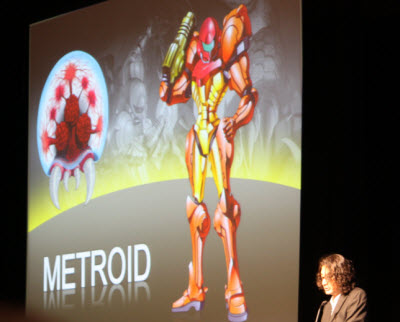 It’s a little funny that the producer of the serious game Metroid Other M is also behind the comic expression of Nintendo’s WarioWare series of handheld games.
It’s a little funny that the producer of the serious game Metroid Other M is also behind the comic expression of Nintendo’s WarioWare series of handheld games.
In a talk before hundreds of game developers today at the Game Developers Conference, Yoshi Sakamoto talked about his career making Metroid games for Nintendo since 1986. The games, which star the heroine Samus with a signature “arm cannon,” are known for their serious dramatic style and shooting action. But Sakamoto said he also loves to make people laugh with the goofy WarioWare games. That diversity of games has helped Sakamoto stay creative over the decades.
The room was crowded, of course, because Sakamoto’s games have been great commercial successes, selling millions upon millions of games on both handheld and home console platforms over the years. His latest Metroid Other M game ships in May, while WarioWare D.I.Y. ships on the Nintendo DSi on March 28. Both are expected to be high-profile Nintendo titles. The Metroid title in particular is crucial for Nintendo to hang on to its hardcore fans; and its emotional storyline with a female protaginist also offers the hope of a much broader audience than usual.
 Sakamoto aid found his serious stylistic inspration in the horror films of Dario Argento, creator of the Italian films Suspiria and Deep Red. Argento was great at controlling the mood, timing, foreshadowing and contrast. He used music and sound effects to create the emotions of fear in the audience. He invoked fear through mastery of foreshadowing and increased the felling of tension by contrasting both storylines and scenes.
Sakamoto aid found his serious stylistic inspration in the horror films of Dario Argento, creator of the Italian films Suspiria and Deep Red. Argento was great at controlling the mood, timing, foreshadowing and contrast. He used music and sound effects to create the emotions of fear in the audience. He invoked fear through mastery of foreshadowing and increased the felling of tension by contrasting both storylines and scenes.
Sakamoto said he shared these same techniques in the creation of the scary scenes in Metroid Other M. He was also inspired by films of Luc Besson (Leon: The Professional), John Woo (A Better Tomorrow), and Brian De Palma (Carrie). He particularly liked the last scene of Carrie. At the same time, he loves making audiences laugh. Even in comedy, he still uses mood, timing, foreshadowing and contrast. He likes to steer a conversation to set up great one liners.
 Sakamoto picks up creative thoughts anywhere he can and then stores them away until he needs them. Then he integrates them into games as the ideas become fully baked. Some of his ideas led to the creation of Nintendo’s iconic Mii characters, which were fully developed by Nintendo’s design chief, Shigeru Miyamoto. Sakamoto said he was proud of the goofy game, Tomodachi Collection, a DS game that launched in Japan in June, 2009. In that game, the story is driven by the player, who can create more of their own story elements. While designing that game, he said to one team member, “You have to take off your underwear!” The idea was that guy needed to loosen up.
Sakamoto picks up creative thoughts anywhere he can and then stores them away until he needs them. Then he integrates them into games as the ideas become fully baked. Some of his ideas led to the creation of Nintendo’s iconic Mii characters, which were fully developed by Nintendo’s design chief, Shigeru Miyamoto. Sakamoto said he was proud of the goofy game, Tomodachi Collection, a DS game that launched in Japan in June, 2009. In that game, the story is driven by the player, who can create more of their own story elements. While designing that game, he said to one team member, “You have to take off your underwear!” The idea was that guy needed to loosen up.
With Metroid Other M, he wrote a story that takes place between the time of the games Super Metroid and Metroid Fusion in the early 1990s. He brought in a male character to co-star with Samus, creating tension between main characters. Then he found a partner, Team Ninja, an outside game developer, to work on the game itself. The goal was to make the ultimate Metroid game. When planning, Sakamoto wanted to be able to control the game using only the Wii remote. That meant the character would have to move along a pre-determined path. Then Team Ninja wanted to add use of the Nunchuk attachment, and then introduced the idea of controlling character movement in a 3-D space using just the control pad on the Wii remote. So the control scheme includes both 3-D and 2-D movement styles.
Two movie production companies, Taiyo Kiakaku and D-Rockets, created the movie-like video scenes that take place in between the game play. For those scenes, the team used comic book storyboards to plan video sequences. Sakamoto’s take-away thought: Combine the techniques that work for both horror and comedy into a game, and you can create something that reaches the emotional core of your audience. Imagine, he said, what you see or want to see on the faces of people as they play your game, and then explore how you can create something that produces those results.
“What we create touches the hearts and feelings of people and can move them,” he said. “We often don’t realize it.”
Richard Lemarchand, lead designer of Sony’s Uncharted 2: Among Thieves, said the talk resonated with him about the commonality between horror and comedy.
“You have to set it up, and then you have to have a pay off,” he said.


